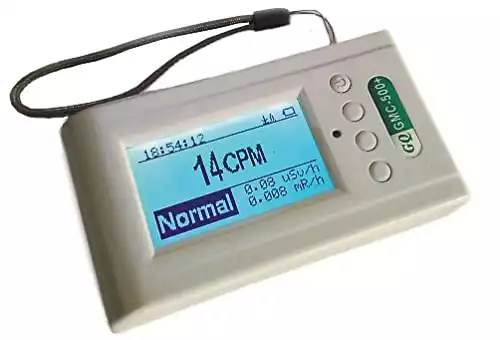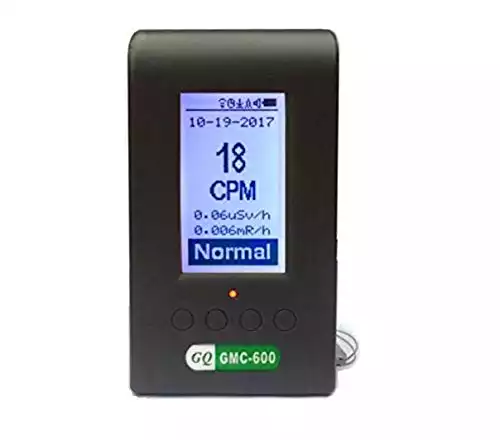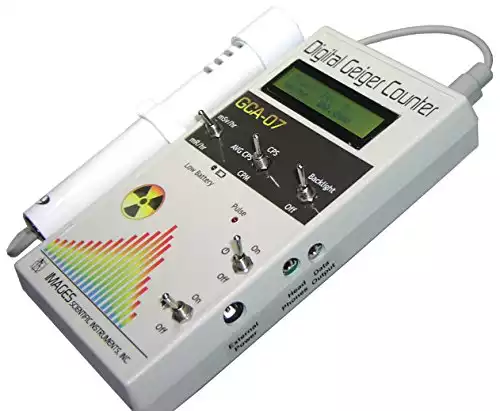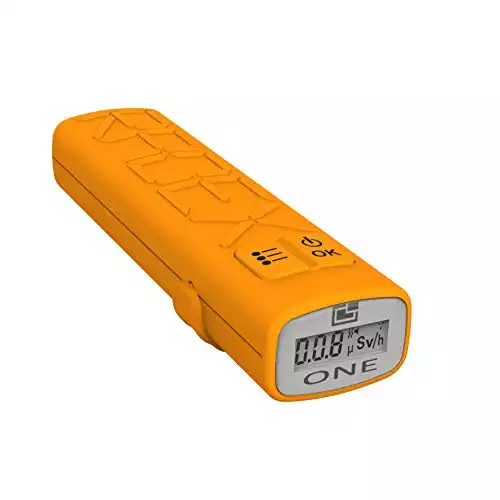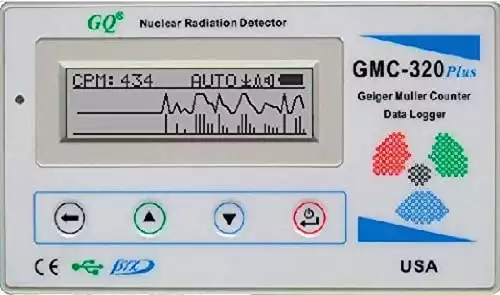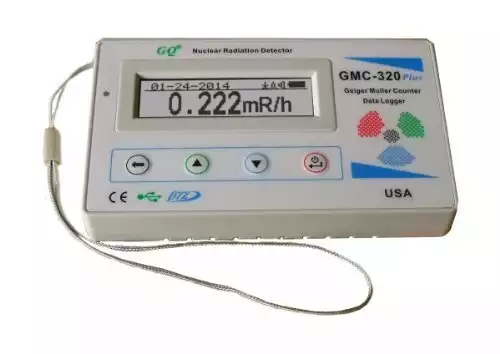So you want to buy a Geiger counter for emergency prepping? As if radiation metrology wasn’t challenging enough, choosing the right Geiger counter is a science in itself!
This guide is meant to help you understand which type of Geiger counter you need, what they can detect, and its features. I’ve also included a list of the best Geiger counters for every budget.
 GQ GMC-500+ Geiger Counter
GQ GMC-500+ Geiger Counter
An easy-to-use Geiger counter with two tubes: one for detecting low-range radiation and the other for high-range. It has a higher max range than any other consumer-grade product we’ve seen.
 GQ GMC-600+ Geiger Counter
GQ GMC-600+ Geiger Counter
Also detects Alpha radiation and has a very sensitive pancake-type sensor, which means you can use it across multiple applications including disaster prepping. There are also tons of extra features for people who want to get into dosimetry.
Comparison Table
|
Detects:
Beta, Gamma, X-ray
|
Detects:
Alpha, Beta, Gamma, X-ray
|
Detects:
Alpha, Beta, Gamma, X-ray
|
Detects:
Beta, Gamma, X-ray
|
Detects:
Beta, Gamma, X-ray
|
Detects:
Beta, Gamma, X-ray
|
|
WiFi:
Yes
|
WiFi:
Yes
|
WiFi:
Yes
|
WiFi:
No
|
WiFi:
Yes
|
WiFi:
No
|
|
Max CPM:
982,980
|
Max CPM:
982,980
|
Max CPM:
600,000
|
Max CPM:
99,900
|
Max CPM:
65,535
|
Max CPM:
65,535
|
|
Max uSv/h:
42,500
|
Max uSv/h:
4,250
|
Max uSv/h:
1,000
|
Max uSv/h:
999
|
Max uSv/h:
328
|
Max uSv/h:
328
|
|
Cumulative dose:
Yes
|
Cumulative dose:
Yes
|
Cumulative dose:
No
|
Cumulative dose:
Yes
|
Cumulative dose:
No
|
Cumulative dose:
No
|
|
Data Logging:
Yes
|
Data Logging:
Yes
|
Data Logging:
Yes
|
Data Logging:
Yes
|
Data Logging:
Yes
|
Data Logging:
Yes
|
|
Alarm:
Yes
|
Alarm:
Yes
|
Alarm:
No
|
Alarm:
Yes
|
Alarm:
Yes
|
Alarm:
Yes
|
|
Wand:
Internal
|
Wand:
Internal
|
Wand:
External
|
Wand:
Internal
|
Wand:
Internal
|
Wand:
Internal
|
|
$148.00
|
N/A
|
$484.95
|
N/A
|
$137.98
|
$128.98
|
Why Would You Want a Geiger Counter?
A Geiger counter allows you to measure radiation levels after a nuclear blast or accident. This information could help inform you about:
- Areas to avoid
- Whether you need to take shelter
- When to come out of shelter
Yes, Geiger counters really can be useful post-disaster. For example, volunteers used DIY Geiger counters after the Fukushima disaster to check radiation levels. They recorded the data with GPS coordinates and made it publicly available.
Do You Really Need a Geiger Counter?
Geiger counters are popular with antique hunters to find products made with uranium. Rock collectors often have them. And they are fun science tools to play with. You can even make your own as a DIY project.
After the Chernobyl miniseries premiered, many people became interested in Geiger counters for prepping. You could use the Geiger counter to measure radiation levels after, for example, a dirty bomb attack. Then you’d know whether you need to shelter or not and which areas to avoid.
However, this isn’t necessarily a good thing:
Having a Geiger counter – especially if you don’t understand how it works – can lead to unnecessary panic. You must ensure you get the correct Geiger counter and understand what it reads!
Geiger Counters Are Useless If You Aren’t Prepped
It’s pointless to know radiation levels if you have no way of protecting yourself from them. So, before you rush out and buy a Geiger counter, ensure you have covered other aspects of nuclear prepping first.
Read:
- How to build a nuclear survival kit
- Nuclear fallout shelters near you
- What to pack in your Bug Out Bag
What is a Geiger counter?
A Geiger counter, also called a Geiger-Mueller tube or G-M counter is a device that can measure radiation particles.
Specifically, they measure ionizing radiation with enough energy to cause electrons to leave their atoms. Geiger counters have many limitations. However, compared to other radiation detectors, they are affordable and can even be made as a DIY project.
How Geiger Counters Work
Geiger counters consist of a tube filled with inert gas. A wire runs down the tube. A battery gives the wire a positive charge. When radiation enters the tube, electrons are knocked off the gas atoms inside.
These electrons are attracted to the charged wire. As they rush towards the wire, the electrons knock off more electrons in what’s known as a “Townsend avalanche.”
The avalanche causes a surge of current. The clicking sound you hear on a Geiger counter is from the current rapidly jerking the speaker components.
As described in this US Nuclear Regulatory Commission Guide,
“The current goes to the information display and moves a needle across a scale or makes a number display on a screen. These devices usually provide “counts per minute,” or the number of ion pairs created every 60 seconds. If the loud speaker is on, it clicks every time an ion pair is created. The number of clicks indicates how much radiation is entering the Geiger counter chamber.”
Limitations of Geiger Counters
1. Can’t Differentiate between types of Radiation
The main limitation of a Geiger counter is that it can’t differentiate between types of radiation.
For example, you’d get the same reading regardless of whether low-energy gamma or high-energy gamma radiation hit the Geiger counter.
Distinguishing Different Types of Radiation
The different types of radiation have different penetrating abilities. For example:
- Alpha rays can’t pass through paper
- Alpha and Beta rays can’t pass through aluminum
- Gamma rays are the most penetrating and will pass through aluminum
You can use this information to tell which type of radiation your Geiger counter is picking up:
- Block the object with a piece of paper, and you’ll get a reading for Beta and Gamma rays
- Block the object with a piece of aluminum, and you’ll get a reading for just Gamma rays
- Subtract the difference between these two readings, and you’ll get the value of just Beta rays.
2. Aren’t Accurate for Measuring High Levels of Radiation
Geiger counters also aren’t very accurate when it comes to measuring high levels of radiation. This is because they experience “dead time” after taking readings.
As described here,
“At high rates of radiation, the tube is not so accurate because each event of ionization is followed by an intensive period called dead time, during which any further incident radiation does not contribute to a count. Generally, the dead time reduces indicated count rates beyond 104-105 counts per second. This depends on the features of the tube used. Some Geiger counters possess circuitry to compensate for this, but still, ion chamber instruments are preferred for accurate measurements of high radiation rates.”
3. Clicks Need to Be Converted into Measurement Units
Geiger counters give readings in “clicks per minute” or CPM. More clicks generally mean a higher level of radiation. However, the value of one click isn’t going to be consistent across Geiger counters. This has to do with “noise” in the environment and the Geiger counter’s sensitivity.
Most modern Geiger counters are pre-calibrated to account for this noise. They can then reliably convert the clicks into measurement units, such as mR/hr or mSv/hr.
For example:
Most Geiger counters are calibrated Cs137. At this calibration, a reading of 1,200 CPM equates to 1 mR/hr.
4. Must Be Recalibrated
Geiger counter readings become inaccurate over time. For example, radiation exposure can cause permanent changes to the electrons inside the Geiger counter. The Geiger counter then becomes “out of tune.” It will still make clicks – but one click won’t represent the same amount of radiation as before.
To ensure it is still accurate, Geiger counters need to be recalibrated approximately once per year.
Recalibration involves measuring a known radioactive source (amateurs often use antique uranium glass plates) with a calibrated machine and setting your Geiger counter to these levels.
Since it’s dangerous to keep radioactive materials in your home, you’ll probably need to have this professionally done! You can read more about calibration here.
What’s the Difference between a Geiger Counter and a Dosimeter?
A Geiger counter measures the number of radioactive particles at a specific location and time. By contrast, a dosimeter measures the total amount of exposure to radioactive materials over time.
For example:
Let’s say your Geiger counter gives you a reading of 60R/hr. If you stay in that location for ½ an hour, the dosimeter will read 30R. If you waited for two hours, your dosimeter would read 120R.
Dosimeters often look like little pens or tubes, stickers or badges. They sometimes have digital readouts and alarms.
Some Geiger counters include dosimeters. However, this can be misleading info. Remember that Geiger counters cannot differentiate between low and high-energy radiation. Exposure to low-energy radiation could make it seem like you got a larger dose than you really did.
On top of that, the accuracy of cheap Geiger counters can be off by more than 10%. This can skew the dosimeter reading.
You’d be better off getting a personal dosimeter like this one.
Guide to Choosing a Geiger Counter
What Type of Radiation Does It Detect?
Many cheap Geiger counters only detect Beta and Gamma radiation and do not detect Alpha radiation. If you want to use the Geiger counter for rock surveying, then you need Alpha detection. However, detecting Beta and Gamma radiation is probably adequate for disaster preparedness.
Note: While Alpha radiation isn’t as dangerous, it can still kill you. If you want to detect Alpha radiation, be prepared to pay for a more expensive Geiger counter.
Certified for Accuracy
The Nuclear Regulatory Commission is in charge of certifying Geiger counters for accuracy. Products which have the NRC certification are reliable and will have accurate readings.
Remember that Geiger counters need to be recalibrated as they age. The NRC also licenses laboratories for calibrating Geiger counters according to ANSI-STD N323A standards.
Unfortunately, NRC Certified Geiger counters are not cheap. Some brands, like this one, are “Certification Ready,” – meaning you can pay an additional fee to have the product certified.
Digital vs. Analogue
Old Geiger counters – like the Civil Defense ones you can find on eBay, are analog. They give a reading in Clicks Per Minute. Newer digital Geiger counters have digital displays which automatically convert this info into measurements.
Usually, you can switch between imperial (mR/hr) and metric measurements (mSv/hr) with a button press. Many digital Geiger counters now also have dosimeters built in.
Not sure how much radiation is dangerous? See this chart.
Want to convert between units of radiation? Use this conversion table.
Probe vs. Pocket Model
Geiger counters can be divided into probe and pocket models:
- Probe Models: The GM tube is located at the end of a wand attached to the unit with a cable.
- Pocket Models: The GM tube is built into the case.
If your reason for getting a Geiger counter is so you can measure radiation levels outside of your fallout shelter, you need a probe model. You leave the probe outside the shelter and still get readings so you’d know when it was safe to come out.
Sensitivity
“Sensitive” Geiger counters can count more radiation particles. For example, a sensitive counter might detect 1,000 particles, whereas a less-sensitive counter only counts 500. They are also able to detect radiation from weak sources and further away.
You don’t necessarily want a very sensitive Geiger counter for disaster prepping. At high levels, you won’t get an accurate reading. Sensitive models can get “saturated” when exposed to high levels of radioactivity. They then get maxed out and need to be recalibrated.
So think hard about whether you need to measure small or large amounts of radiation as part of your prepping plan!
*A lot of Geiger counters let you switch the sensitivity. For example, a Geiger counter with a sensitivity of 500 CPM might let you switch to 10x or 100x. The needle on the Geiger counter will shoot up as you increase the sensitivity, even though it is reading the same object.
Range
Geiger counters can only measure a limited range of radiation. Because most Geiger counters are made for surveying rocks, the range is usually very low. While these would work for measuring distant fallout, they are useless for measuring high levels after a nearby blast.
Low-range Geiger counters will read from 1-100 or 1-200 mR/hour. Higher-range Geiger counters can read over 400 mR/hr. Some high-range Geiger counters can read over 1,000 mR/hr.
What about Civil Defender Geiger Counters?
Even though the technology around Geiger counters hasn’t changed much, I don’t recommend buying one of those old Civil Defender Geiger counters. The exception is if you can find one sold directly from a company that calibrates and certifies the calibration.
Another reason to avoid the Civil Defender Geiger counters (and other old Geiger counters) is the battery they use. Some of them require lead-acid batteries, which are incredibly difficult to find. You are probably better off with a newer model that uses long-lasting batteries.
Best Geiger Counters Reviewed
When it comes to Geiger counters for prepping, there aren’t too many options. Your best options are from the brands GQ, Radex, or Imagesco.
GQ Geiger Counters
GQ makes a wide range of affordable Geiger counters. They aren’t the most accurate Geiger counters (expect a 10-15% accuracy range). So, I wouldn’t choose a GM model if you want to reliably measure radiation in food or rock samples.
However, they are good enough for getting a general idea of environmental radiation after a disaster.
The cheaper GM Geiger counters (the 300E and 320+) have a low range, so they will max out (and thus give false readings) in high radiation situations. However, the GQ GMC 500+ and GMC 600+ models have higher ranges than you’ll find with other consumer-grade Geiger counters.
There are also a lot of extra features on almost all GQ Geiger counters, like Wifi connectivity, automatic data logging, and intuitive software.
Which GQ Geiger counter to get?
For disaster prepping, the GMC 500+ is a great choice. It has two tubes: one for low-range and the other for high-range readings. The reading maxes out at 42,500 uSv/h.
If you can afford it and want to get into dosimetry, then the GQ GMC 600+ is the better choice. It has tons of features and a very sensitive pancake-type tube. This tube is the reason the model costs so much more.
Radex Geiger Counters
Radex Geiger counters are also really popular. They make several models, but the Radex One best suits most preppers’ needs. It has a reasonably high range, and the tube is good quality (uses the SBM-20-1 Geiger-muller tube).
Compared to GQ Geiger counters, Radex doesn’t seem to hold up as well. Plus, they are made by a Russian company. Because of the current political situation, I wouldn’t trust the quality control on Russian-made products, nor would I expect decent support from them.
Images GCA-07W
Images are a smaller brand that has been making scientific instruments since the 1980s. Their GCA-07W Geiger Counter is not cheap, but it has some features you won’t find with other consumer-grade Geiger counters.
- American-made tube: They use the LND 712 Geiger Mueller (GM) Tube, which was made in the USA and is generally better than the Chinese tubes used in GQ Geiger counters.
- NRC Certification available: For an extra fee (currently $125), you can get the Geiger counter inspected and certified, so you know it will be accurate. The fact that they offer this shows just how accurate their Geiger counters are.
- External probe: Useful if you want to measure radiation from surfaces.
Because the tube has good sensitivity, you can use it to monitor low levels (such as food contamination) and high environmental radiation levels.
Like with every other consumer-grade Geiger counter, it will max out fairly quickly if exposed to very high radiation levels.
- https://www.einsteinmed.edu/administration/environmental-health-safety/radiation-safety/geiger-counter-calibration-repair.aspx
- https://www.x-zlab.com/radiation-detector/difference-between-survey-meters-geiger-counters-and-dosimeters/
- https://www.reddit.com/r/ChernobylTV/comments/c1oeyc/i_now_want_to_buy_a_geiger_counter_anyone_else/
- https://www.quora.com/I-own-a-geiger-counter-and-detected-a-sudden-around-30-second-spike-in-radiation-levels-of-around-twice-background-average-What-could-this-be
- https://ecotestgroup.com/press/blog/how-to-use-a-geiger-counter/
- https://www.reddit.com/r/nuclear/comments/o07o4x/choosing_a_geiger_counter_living_near_a_nuclear/
- https://soeks-usa.com/blogs/radiation/blog-what-is-cpm-in-radiation
- https://www.co.monmouth.nj.us/documents/118/RADIATION%20HEALTH%20BASICS.pdf
- https://cs.stanford.edu/people/nick/geiger/
- https://www.quora.com/How-long-would-the-average-geiger-counter-last-if-used-non-stop
